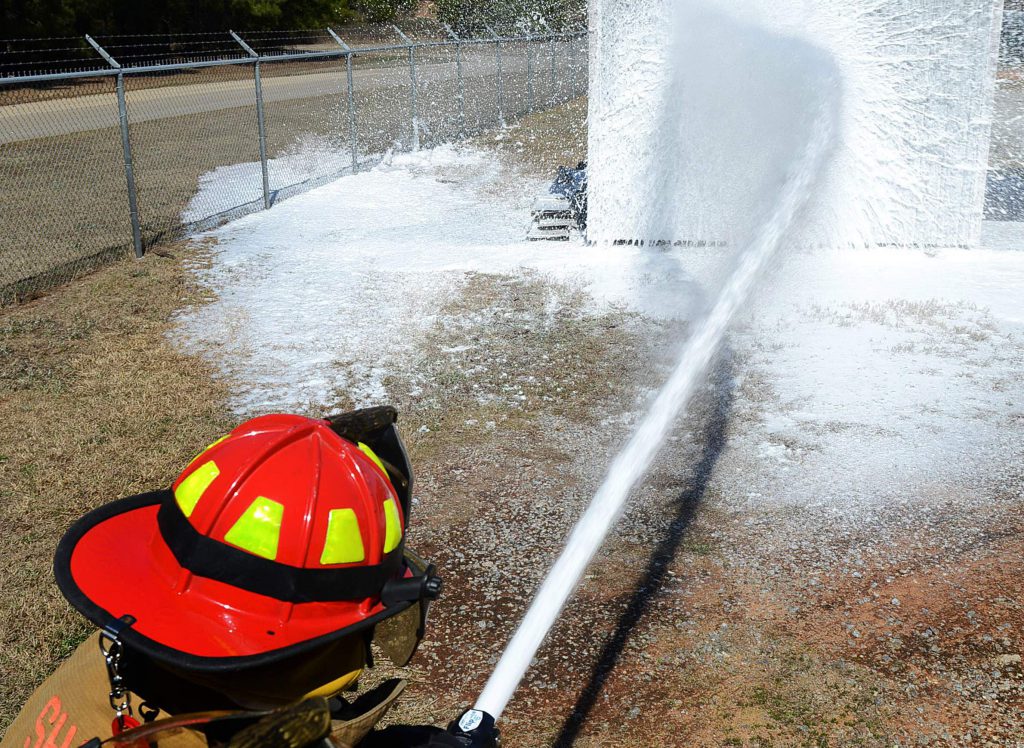2/3rds of State’s Fire Departments Stock Foam With PFAS
More than half have used the firefighting foam that contains the harmful substance.
Nearly two-thirds of Wisconsin fire departments currently stock firefighting foam that contains so-called forever chemicals known as PFAS. More than half have bought, stored or used such foam in the past, according to a survey conducted by the Wisconsin Department of Natural Resources.
Perfluoroalkyl and polyfluoroalkyl substances — known as PFAS — are manmade chemicals that have been common in firefighting foam and everyday products since the 1950s. They’ve raised safety and environmental concerns because they don’t break down easily in the environment and they’ve been linked to an increased risk of some cancers.
The DNR received responses from 72 percent of the state’s 825 fire departments, of which 77 percent replied that they had handled PFAS-containing foam. The data indicates 64 percent of all departments currently have such foam in stock.
The findings were a bit surprising to Darsi Foss, administrator of the agency’s environmental management division.
“I would have thought it would have been probably a little smaller because usually this is for like major industrial fires,” said Foss, of the foam.
The agency estimates anywhere between 63,200 to 96,300 gallons of the foam is being stored across the state. The DNR said another 30,000 gallons of expired or unwanted foam needs to be disposed.
The majority of those that responded — 63 percent — used the foam as part of emergency response to flammable liquids or gas, according to the DNR. Of those that handled the foam, 62 percent lacked policies or guidelines for its use. Less than 24 percent of departments surveyed used the foam for training and 23 percent said they never handled the foam.
A law that took effect this month bans the use of firefighting foam containing PFAS except in emergencies. The law allows testing, storage and disposal under specific conditions. But fire departments and other facilities using the foam must find alternatives to use for training.
The survey findings demonstrate the need for resources to collect and dispose of PFAS-containing foam, according to Chris Garrison, president of the Wisconsin State Fire Chiefs Association.
“We have it at our fire station. We have it on our trucks, and now we’re we told can’t use it, which we completely understand,” said Garrison. “We bought into it, but the thing is how do we get rid of it? It’s a very expensive process to get rid of it.”
Garrison, who is also chief of the Sun Prairie Fire Department, said his department has seven rigs that have PFAS-based foam in them. He’s received estimates that it would cost $3,000 per vehicle to properly dispose of it.
He said most departments are storing foam until they receive financial assistance to dispose of it.
The Wisconsin PFAS Action Council, which consists of multiple state agencies, has been developing a plan to address PFAS as part of an executive order issued by Evers last year. Foss said a foam collection effort and funding are being considered as part of efforts to help reduce the risk of contamination statewide.
Last month, the Natural Resources Board tabled an emergency rule that would’ve outlined regulations for treatment and disposal under the law, which means departments lack a clear definition on appropriate measures to follow.
“They’re going to have to kind of look at best management practices of industry and work with their environmental consultants to make sure this is being done correctly,” said Foss. “They can look at our versions of our draft rules to kind of understand where we’re going with this.”
The board delayed action after business groups expressed concerns about limits the agency proposed for treatment. The board is expected to address the rule again in October.
The DNR estimates there are as many as 200 public and private systems that use PFAS-containing foam for fire suppression, costing them an average of $2.3 million each year to comply with the law’s disposal requirements. The agency expects those costs will be less than the amount to clean up contamination and decline over time as replacement foams are used.
There are around 30 sites across Wisconsin that the DNR is investigating for PFAS contamination, according to data from the agency’s website. Foss said a large share, but not all, of the investigations are linked to the use of firefighting foam.
Listen to the WPR report here.
Nearly Two-Thirds Of Wisconsin Fire Departments Stock Firefighting Foam That Contains PFAS was originally published by Wisconsin Public Radio.
More about the PFAS Problem
- Environmental Groups, Community Advocates Push for PFAS Deal - Henry Redman - Jul 14th, 2025
- Environmental Advocates Hail Wisconsin Supreme Court Decision in Evers v Marklein - Midwest Environmental Advocates - Jul 8th, 2025
- Wisconsin Supreme Court Backs State Regulators of PFAS Pollution - Danielle Kaeding and Rich Kremer - Jun 24th, 2025
- Gov. Evers Releases Statement on Wisconsin Supreme Court Decision in WMC Inc v. DNR - Gov. Tony Evers - Jun 24th, 2025
- Rep. Shelia Stubbs Elected Great Lakes-St. Lawrence Legislative Caucus Vice Chair of the Task Force on Emerging Contaminants - State Rep. Shelia Stubbs - Jun 16th, 2025
- Legislature’s Budget Committee Unanimously Boosts Clean Water Funding By $732 Million - Danielle Kaeding - Jun 6th, 2025
- Trump Administration moves to weaken standards for toxic ‘forever chemicals’ in drinking water - Clean Wisconsin - May 14th, 2025
- Wisconsin Officials Unhappy With EPA Plan To Weaken PFAS Standards - Danielle Kaeding - May 14th, 2025
- Wisconsin Could Lose $55 Million Under Proposed EPA Budget Cuts - Danielle Kaeding - May 7th, 2025
- French Island Makes Progress on PFAS Pollution - Richelle Wilson and Trevor Hook - Mar 24th, 2025
Read more about PFAS Problem here





















